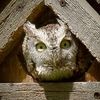Need help with Hummers' wings
Jun 28, 2012 17:56:47 #
glojo
Loc: South Devon, England
I'm reading all this technical talk but I tend to keep things so much easier. I fully, TOTALLY accept a bee is not a humming bird and I also acknowledge that folks will tell me I should not go off topic but how fast do the wings of a bee move compared to a humming bird?
Look at the shutter speeds everyone is talking about and the ISO speeds that go with them.
This image is hand held at just 1/60th of a second :shock: :oops:
Yes 1/60th, I have used an f stop of f22 to get the depth of field but would you need that with your humming bird? If not you could lower the ISO from 400 ... Yes 400 down to 200 and look at those wings of the bee. Yes it was alive, yes it had its main engines going and yes those wings were moving.
1/60th f22 ISO 400
Look at the shutter speeds everyone is talking about and the ISO speeds that go with them.
This image is hand held at just 1/60th of a second :shock: :oops:
Yes 1/60th, I have used an f stop of f22 to get the depth of field but would you need that with your humming bird? If not you could lower the ISO from 400 ... Yes 400 down to 200 and look at those wings of the bee. Yes it was alive, yes it had its main engines going and yes those wings were moving.
1/60th f22 ISO 400

Jun 28, 2012 18:58:12 #
Jun 28, 2012 20:32:12 #
Jun 28, 2012 20:40:09 #
glojo wrote:
I'm reading all this technical talk but I tend to ... (show quote)
Nice image. Did you use a flash? Probably not at 1/60th.
Jun 28, 2012 21:57:52 #
glojo
Loc: South Devon, England
GAClowers wrote:
quote=glojo I'm reading all this technical talk b... (show quote)
:oops: :oops: :oops: A hundred apologies for not mentioning I used flash and yes I did... Good spotting and I feel awful for not mentioning this, so much so it is 2-50am in the morning (hence the am). I had a feeling I had forgot and I'm in so much pain that I cannot sleep so decided to check to see if I had mentioned this VERY relevant fact. :oops: :oops: :oops: It is a camera mounted Sigma unit, no other external flash units.
I have no idea though about your other remark.
GAClowers wrote:
Probably not at 1/60th.
The shutter speed was one sixtieth of a second = 1/60th
Jun 29, 2012 00:31:00 #
glojo wrote:
quote=GAClowers quote=glojo I'm reading all this... (show quote)
No offense intended. I just meant that at the relatively slow speed of 1/60th you may not have needed additional light. I don't know how light your surroundings were.
Jun 29, 2012 04:48:00 #
glojo
Loc: South Devon, England
GAClowers wrote:
No offense intended. I just meant that at the relatively slow speed of 1/60th you may not have needed additional light. I don't know how light your surroundings were.
Hi Gazil,
Absolutely no offence taken :) You have raised another very good point and I fully understand your reasoning so here are my reasons for using flash, but before rambling on about them you asked the question about freezing the wings of a humming bird that is in flight. If I had simply said use a flash plus shutter speed of 1/60th of a second at f22 and an ISO of just 400 you might have laughed at me and thought I was raving barking mad?
I am in the corner that likes to see examples of recommendations that folks give and if they suggest 'x', 'y' and 'z', then they should show an example that corroborates that recommendation. The joy of shooting the humming bird is that you can use a tripod and that gives you far more options to experiment with.
Here we go.....
The first reason for using flash was this plant was located in a very shadey part of the garden. It was a dismal, dark day and we are talking about England with our typical summer weather :oops: :-D :-D but..........
The main reason however was to freeze those wings. Look at all the camera settings folks are recommending!! If I had NOT used a flash then I doubt my Nikon D300 would have had enough adjustments to have taken that image in those self same conditions? In your opinion what speed would you require to freeze those wings even in better conditions with decent light? (polite question to which I do not know the answer and I have tried doing it)
Might I ask if the wings of a bee might move faster than those of the amazing humming bird and this is a question to someone that has knowledge of these beautiful creatures and whose opinion I value? My thoughts on this are that the bee has an amazing ability to move its wings at unbelievable speeds far in excess of bird? (polite question)
Reading all these posts if we want to freeze those wings without using a flash, we are looking at shutter speeds that are pushing the camera and then to cater for those speeds we then have to push the ISO up to levels that might cause graining.
What is easier, use a flash and a comfortable shutter speed plus the very low ISO or no flash and all these mind boggling big numbers?
I really like your idea of freezing the wings as it is something we seldom see, it would be nice to see feather formations, muscle definition and of course the flexing of the birds wings and well done for trying, I would love to see the underneath view of the frozen wings.. :thumbup: :thumbup:
Hopefully you will look at my suggestion and possibly give it a try? You certainly do NOT have to use 1/60th if your flash is capable of higher speeds. I just found this configuration capable of freezing the wings of a bumble bee and that..... Is not easy unless you have some very expensive lighting equipment :thumbup: :thumbup:
Jun 29, 2012 09:56:53 #
glojo wrote:
quote=GAClowers No offense intended. I just mean... (show quote)
Hi glojo, greetings to Devon from Tacoma. I'm glad we started this conversation because it urged me to do some research. Here is what I found about wing speeds. Bumble Bee (Bombus) flaps about 180/sec., Honeybees an amazing 230/second. Hummers are relatively slow at only 80 per second. This is why I was interested to note that you got that great picture of the Bombus at only 1/60th. I always shoot my hummers at a minimum of 1/2000 or higher which requires a flash even if I have the aperture very open. I am not really trying to totally freeze the motion of the hummer wings because I like the motion effect of a slight blur. I have never really tried to freeze bee's wings, usually trying for a sitting shot, but rest assured I will now make that a project. Here is another example of a hummer that I like. I took this with high speed shutter and medium aperture which gave a shallow depth of field, clear image of the body and some motion of the wings. Nice to visit with you from such a long didstance.

Jun 29, 2012 10:44:19 #
donrent
Loc: Punta Gorda , Fl
[quote=Fergus]Donrent,
Thank you for your kind words and, more important, another
========================================
Ya, thats about what I meant... I am not a long winded guy...
Thank you for your kind words and, more important, another
========================================
Ya, thats about what I meant... I am not a long winded guy...
Jun 29, 2012 10:48:09 #
glojo
Loc: South Devon, England
GAClowers wrote:
What EXCELLENT information and thank you very much for the research. Here is what I found about wing speeds. Bumble Bee (Bombus) flaps about 180/sec., Honeybees an amazing 230/second. Hummers are relatively slow at only 80 per second. This is why I was interested to note that you got that great picture of the Bombus at only 1/60th. I always shoot my hummers at a minimum of 1/2000 or higher which requires a flash even if I have the aperture very open.
I am a complete amateur and simply take snaps, ask me a nitty, gritty question and I would be lost, however I do enjoy a challenge, hence that picture.
I have read posts of folks using a flash over long distances but are they aware of what they are really doing? I took a picture of a badger at about 11-30pm, and using a flash over any distance in excess of three to four metres was not really of any benefit other that getting a reflection from the animal's eyes :(
Why am I saying this?
GAClowers wrote:
I always shoot my hummers at a minimum of 1/2000 or higher which requires a flash even if I have the aperture very open
You are the expert regarding these birds and how close can you get your camera? If you can get the camera within 2 metres then is it worth trying my settings as a baseline? I'm not sure they will work if you are only using the camera's flash but they should if you have a decent flash for the camera. If you were close enough then clearly that fast speed is not needed which will then give you lots more freedom of choice regarding the other settings. :thumbup:
I love looking at the detail of the birds feathers when they are in flight, they can tell the experts so much and to me they just look interesting and if you have a decent lens that can pick up the detail, then maybe you might also find this topic to be of interest? The bottom line would be that unless we try, we will never know :)
Jun 29, 2012 13:36:37 #
I think this is a beautiful shot. I agree, the movement of the wings add to the subject. I have been trying to get some decent hummer shots lately and have nothing half this good.
Jul 2, 2012 14:27:40 #
In the Hummingbird vs Bumble bee wing speed controversy, it is not the beats per minute that are important but the speed of the wing tip. With the bee, whose wing may only be 3/8 long, the distance the tip travels is not very much, perhaps only 3/8. With the Hummer the wing tip may be traveling 4 or 4 ½. So, at 12000 (200 per second) beats per minute times 3/8 = 4500 per minute for the bee. At 3000 (50 per second) beats per minute times 4 ½ = 13500 per minute for the Hummer. So the wing tip speed for the hummer is more than 3 times the speed of the bee. Please dont quote me on the exact distances travelled as these are only a guess but it gives you an idea of what you are facing.
My experience indicates that a shutter speed of 1/2000 sec will slow but not stop a hummers wings but it all depends on what part of the cycle you catch. When the birds wing is changing from forward to backward it must come to a stop before changing direction. If you catch it at this time, you have a chance to get a sharp wing. If you catch the wing at mid cycle even 1/4000 might not do the job.
As to flash: There are many people who advocate flash as the way to go and I have done some of it myself. Flash works best when it is the sole source of light. If your exposure, exclusive of flash, is close to that of the ambient light, then ghosting can occur. Remember, this is just like using fill or synchro flash. You control the flash exposure with your f/stop and your ambient light exposure with the shutter speed. This means that you may need to use high speed synch to achieve the correct overall exposure of the bird. The background is likely to be dark if it is sufficiently far away as to not benefit from the light from the flash.
My experience indicates that a shutter speed of 1/2000 sec will slow but not stop a hummers wings but it all depends on what part of the cycle you catch. When the birds wing is changing from forward to backward it must come to a stop before changing direction. If you catch it at this time, you have a chance to get a sharp wing. If you catch the wing at mid cycle even 1/4000 might not do the job.
As to flash: There are many people who advocate flash as the way to go and I have done some of it myself. Flash works best when it is the sole source of light. If your exposure, exclusive of flash, is close to that of the ambient light, then ghosting can occur. Remember, this is just like using fill or synchro flash. You control the flash exposure with your f/stop and your ambient light exposure with the shutter speed. This means that you may need to use high speed synch to achieve the correct overall exposure of the bird. The background is likely to be dark if it is sufficiently far away as to not benefit from the light from the flash.
1/2000, f/8, ISO 800 no flash
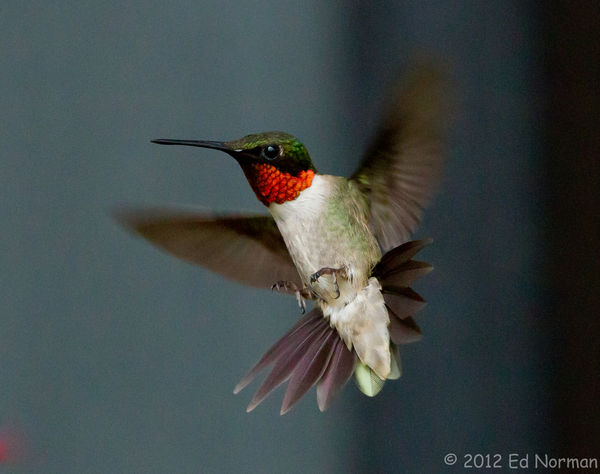
1/2000, f/8, ISO 800, no flash, wings at transition point
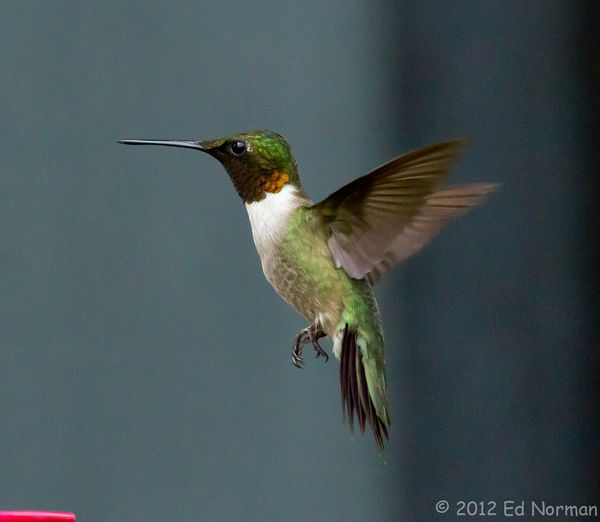
1/60, f/8 ISO 800, with flash, note ghosting especially around the tail.
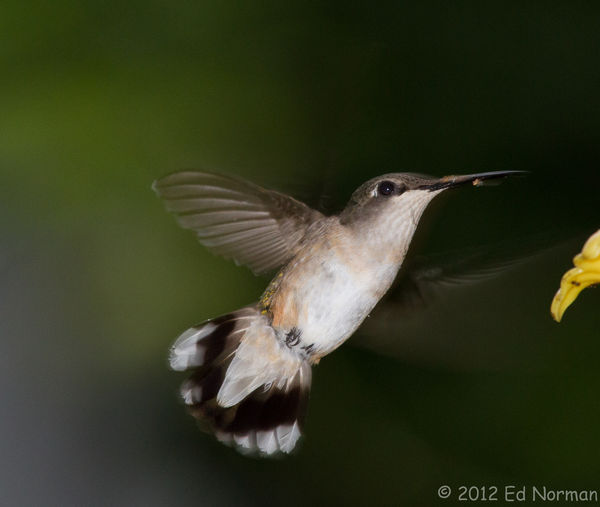
1/1600, f/8, ISO 800, no flash. Note that hummers get lift on both the up and down stroke. Look at the position of the wings on this upward stroke!
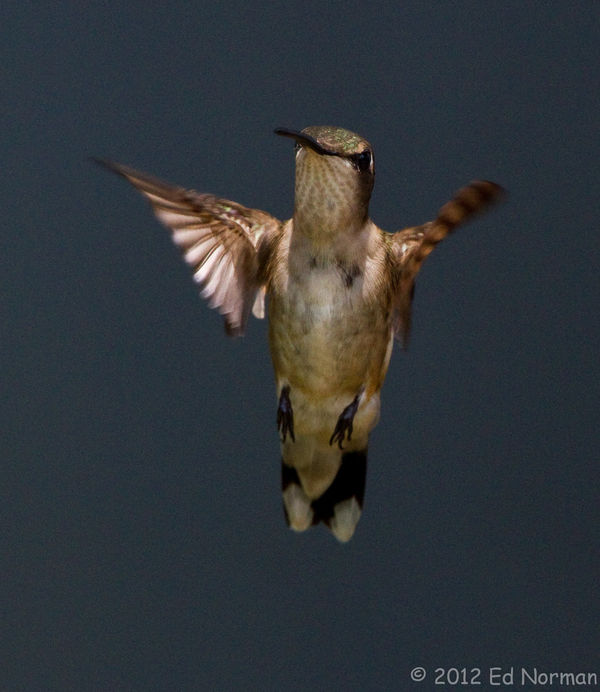
Jul 2, 2012 15:41:05 #
glojo
Loc: South Devon, England
hi Birdpix,
you are without doubt the man when it comes to bird photography but your explanations leave far too many questions regarding the maths but...
Looking at those amazing images of the humming bird you are probably too far away to benefit from the flash to freeze the image.
Excellent pictures which are just typical of what you post...
Envious or what?
I would LOVE the opportunity to just see such a beautiful bird.
you are without doubt the man when it comes to bird photography but your explanations leave far too many questions regarding the maths but...
Looking at those amazing images of the humming bird you are probably too far away to benefit from the flash to freeze the image.
Excellent pictures which are just typical of what you post...
Envious or what?
I would LOVE the opportunity to just see such a beautiful bird.
Jul 2, 2012 16:38:16 #
And with all that wing speed conversation, one can simplify the issue just by asking the bird to pose and smile pretty.

Jul 2, 2012 16:55:20 #
Here are couple I took in Colorado a few days ago.
sigma 150-500 @500mm is0 3200, f10, 1/3200 sec
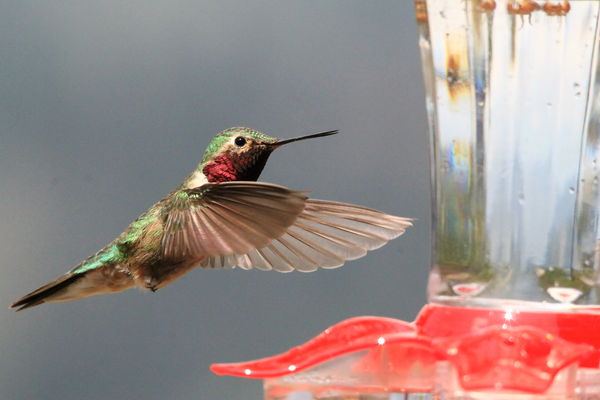
same setting only f13
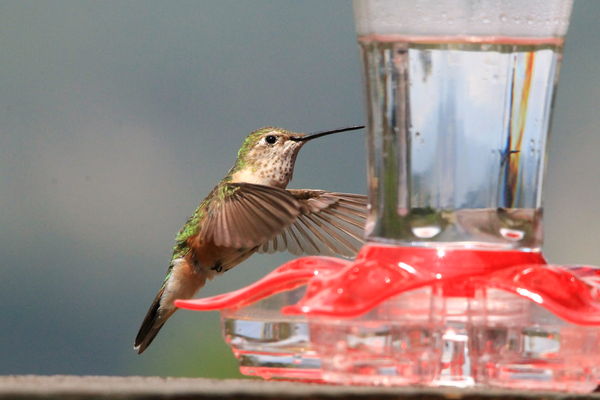
If you want to reply, then register here. Registration is free and your account is created instantly, so you can post right away.


